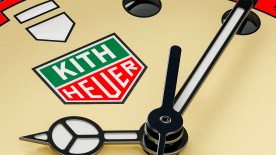Felix Baumgartner: My dad restored old clocks. He worked at IWC prior to creating a boutique-workshop in Schaffhausen. My brother Thomas was an apprentice mechanic at IWC because he was less interested in watches. For my part, however, I loved puzzles and wristwatches. Clocks were far too close to my father’s footsteps. I studied at the watchmaking school in Solothurn and in 1999, Sven Andersen put out an advertisement that read “Haven’t you always dreamed of being independent?”. There were more experienced candidates but they hired me. They let us work part time on personal projects and I did stuff for Vacheron Constantin at the same time as developing Urwerk, with my brother.
How did it all start?
My brother and I had already met Martin Frei through our artist cousins. During a discussion about watches, he took out a notebook and started sketching. What he drew became Urwerk. I invested everything I had earned up to that point which amounted to around CHF 10,000 or 15 000 – and in 1996 a pharmacist friend of my mother’s bought a 101 model in pink gold based on a sketch.

How did you position yourselves in the watchmaking landscape as it then stood?
At that time, watchmaking was going round and round in circles. It was boring and somewhat sedentary. There was no innovation, and you weren’t allowed to do certain things. We wanted to do something current and hand-crafted. We wanted to give the big companies a wake-up call. To invent a watchmaking style we liked.
And that was the 101 model?
The 101 and 102 were created together. The 101 was made of gold. In the end, we made 20 or 25. The 102 was made of steel and we wanted to sell it for the same price as a Rolex – for about CHF 5,000. But we had forgotten the retailers’ margin! We made 50 or 55 of them.

Which retailers?
At the time, Boris Litsof launched a watch department at Bergdorf Goodman in New York, which was based exclusively on brands belong to the AHCI (Académie Horlogère des Créateurs Indépendants, or Horology Academy of Independent Watchmakers). But it didn’t last. Then there was Embassy (Switzerland), Chronopassion (France)… The turning point came with the launch of the 103 in 2003. We moved into the third dimension, that of watches and business. The Control Board (editor’s note: maintenance indications displayed pm the back of the watch) legitimated the concept in horological terms.

Where does your space-related inspiration come from? I know that there is a big scale model of the USS Enterprise in your office …
We all have that in us – it’s part and parcel of our generation (editor’s note: people born in the 1970s). But the space aspect doesn’t come from the watchmakers. It was Martin Frei who was fascinated by space science, especially Russian. The 102 was inspired by the Sputnik – and the four lugs on the strap of the 102 are the four antennae. It was always there from the first minute. Personally I strive to push technical boundaries.

You have become the spearhead of a new generation of watchmaking. How have you handled this success?
For personal reasons, my brother Thomas left Urwerk in 2004. Martin and I have kept our feet on the ground. We know what we want. We made a choice to remain exclusive and to make around 150 watches a year. We don’t like being a small cog in a large wheel. We aren’t businessmen. We keep one family in Geneva and another in Zurich with Martin. He is involved in film-making and architecture. Helping Urwerk evolve is more interesting than managing staff. At the end of the day you must be happy. And today we are just fine the way we are.







